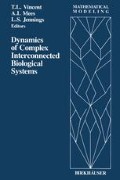Abstract
Biological systems are complex systems, almost by definition. Thus models of such systems necessarily simplify. That even simple models can lead to very complicated behaviour leads us to re-examine the goal of mathematical modelling. We may distinguish two loose categories of model: the “pure” model whose end is the understanding of phenomena, and the “applied” model directed to their control. Central to both is the notion of prediction, and it is this that is seen to be likely to be possible only to a limited degree. These matters are further compounded by the corresponding difficulty in solving the inverse problem of inferring the model from the phenomena. This leads us to query the way in which we might seek to understand the system (in the pure case) and to control it (in the applied one).
Access this chapter
Tax calculation will be finalised at checkout
Purchases are for personal use only
Preview
Unable to display preview. Download preview PDF.
References
Correspondence. 1961. On the topic of “Doomsday”. Science 133, pp. 936–946.
Deakin, M.A.B. 1988. Nineteenth century anticipations of modern theory of dynamical systems. Arch. Hist. Ex. Sci. 39, pp. 183–194.
Drouhard, J.P. 1987. Revised formulation of the Hodgkin-Huxley representation of the sodium content in cardiac cells. Comp. Biom. 20, pp. 333–350.
Euler, L. 1775/1862. Principia pro motu sanguinis per arterias deter-minando. Op. Post. Math. Phys. II, pp. 814–823.
Hardin, G. 1960. The competitive exclusion principle. Science 131, pp. 1292–1297.
Huffaker, C.B. 1957. Experimental studies on predation: Dispersion factors and predator-prey oscillations. Hilgardia 27, pp. 343–383.
Laplace, P.S. 1814. Essai philosophique sur les probabilités. Reprinted in Laplace’s collected works, Vol.7.
Leigh, E.R. 1968. The ecological role of Volterra’s equations. Lect. Math. Life Sci. 1, pp. 1–61.
Lorenz, E.N. 1964. The problem of deducing the climate from the governing equations. Tellus 16, pp. 1–11.
Lotka, A.J. 1920. Analytical note on certain rhythmic relations in organic systems. P.N.A.S. 6, pp. 410–425.
Malthus, T. 1798. An Essay on the Principle of Population, etc. London. Variously expanded, modified and reprinted.
Rescigno, A. 1968. The struggle for life: II. Three competitors Bull. Math. Biophys. 30, pp. 291–298.
Rescigno, A. and Richardson, I.W. 1967. The struggle for life: I. Two species. Bull. Math. Biophys. 29, pp. 377–388.
Serrin, J. 1975. Is “Doomsday” on target? Science 189, pp. 86–88.
Smale, S. 1976. On the differential equations of species in competition. J. Math. Biol. 3, pp. 5–7.
Strandberg, M.W. 1985. Homomorphism on a physical system of the Hodgkin-Huxley equations for the ion conductance in nerve. J. Theor. Biol. 117, pp. 509–527.
Thorn, R. 1972. Stabilité structurelle et morphogénèse. Benjamin: Reading, Mass.
Volterra, V. 1937. Principes de biologie mathématique. Acta Biotheor. 3, pp. 1–36.
von Foerster, H., Mora, P.M. and Amiot, L.W. 1960. Doomsday: Friday, 13 November, A.D. 2026. Science 132, pp. 1291–1295.
Whittaker, E.T. 1941. Vito Volterra. Obit Not F.R.S. 3, pp. 690–729. Reprinted in amended form as a preface to V. Volterra’s Theory of Functionate and of Integral and Integro-Differential Equations, Dover Reprint, New York, 1959.
Editor information
Editors and Affiliations
Rights and permissions
Copyright information
© 1990 Birkhäuser Boston
About this chapter
Cite this chapter
Deakin, M.A.B. (1990). Modelling Biological Systems. In: Vincent, T.L., Mees, A.I., Jennings, L.S. (eds) Dynamics of Complex Interconnected Biological Systems. Mathematical Modelling, vol 6. Birkhäuser Boston. https://doi.org/10.1007/978-1-4684-6784-0_1
Download citation
DOI: https://doi.org/10.1007/978-1-4684-6784-0_1
Publisher Name: Birkhäuser Boston
Print ISBN: 978-1-4684-6786-4
Online ISBN: 978-1-4684-6784-0
eBook Packages: Springer Book Archive

